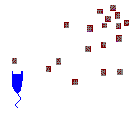|
How does it know which way to go? A bacterium doesn't have a brain, but it does have a very primitive sensing organism, which can detect molecules. It works much like your nose, which can, for example, detect very tiny numbers of perfume molecules in the air, a long way from the source of the perfume. When you detect the perfume 'smell', you can often locate the source of the perfume by turning and following the scent ... your nose can sense when the concentration of molecules is increasing, and you head in that direction. The principles that make this detection system work are based on these facts:
Bacteria can follow a trail of molecules in the same way.  A bacterium has a receptor on one end, which can trap a molecule of its food and hold it for a short time. When the molecule is released, the bacterium will keep moving, by waving its flagellum. A bacterium has a receptor on one end, which can trap a molecule of its food and hold it for a short time. When the molecule is released, the bacterium will keep moving, by waving its flagellum.- If it does not immediately encounter another molecule, it will change direction. - If it does encounter a molecule, and after releasing it, encounters another one right away, it keeps moving in the same direction. In this fashion, the bacterium will continually change direction and move toward a higher concentration of food molecules, eventually arriving at the source. This process is called chemotaxis. |